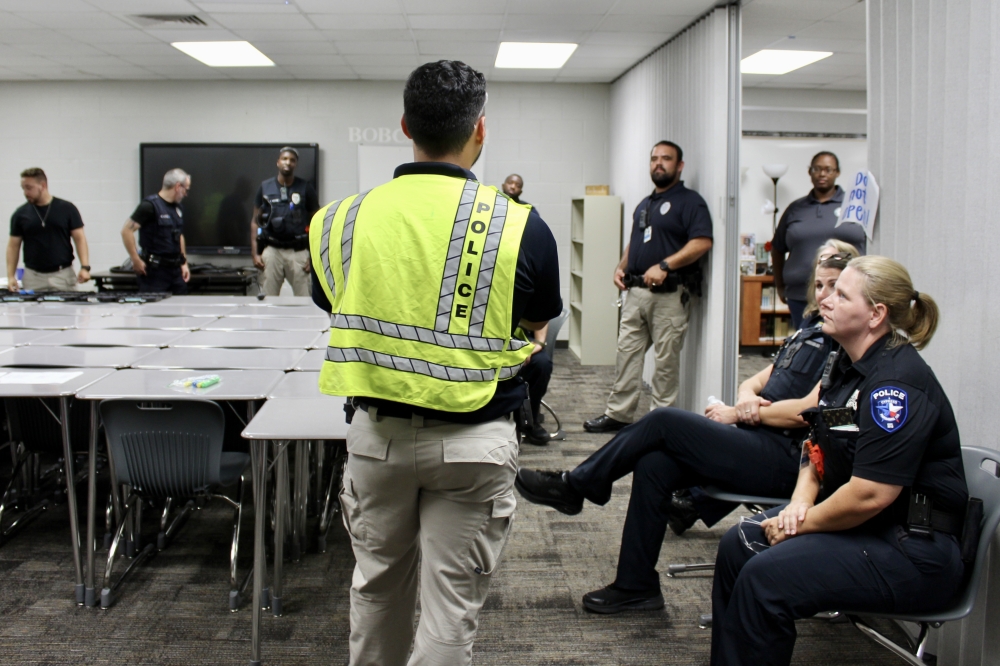Gov. Greg Abbott signed House Bill 3 into law June 14. It provides districts with $15,000 per campus and increases the safety allotment by 28 cents per student—from $9.72 to $10—to fund safety expenses.
Cy-Fair ISD’s Chief Financial Officer Karen Smith said the district should receive an additional $1.4 million per year for safety—about 3% of what the district already planned to spend on safety measures in 2023-24.
“It’s such a minimal amount that we’re receiving with that safety and security allotment that I don’t know that we have it earmarked specifically to one intervention or one measure but just to continue to offset the cost that we currently have,” CFISD Chief of Staff Teresa Hull said.
Allocated funds can be spent on safety infrastructure; the hiring of officers, mental health personnel or a school safety director; firearm training; active-shooter response training; and evidence-based threat prevention efforts, according to HB 3.
CFISD budgeted $49.1 million from its general fund for the 2023-24 school year to cover the district’s police department, psychological services, counselors and the district’s mental health intervention team.
In 2019, CFISD voters approved $207.7 million in safety and security enhancements as part of a $1.76 billion bond package. Most projects have been completed or are in progress, including:
- Additional security cameras
- Lockdown panic buttons
- Upgraded intrusion detection panels
- Classroom phones
- Additional card readers on exterior doors
- Enhanced video intercoms and PA systems
- Secure vestibules at all campuses
- Bullet-resistant glass on doors and in high-traffic areas
- Exterior window and door numbering
- Fencing around portable buildings and playgrounds
- Door prop alarms
- Metal detectors
- Expansion of Ben Bradley Security Center
- Replacement and addition of police vehicles and radios

Starting this school year, each public school in Texas must have at least one armed security officer during school hours. If districts are unable to meet this requirement due to a lack of funds or personnel, school boards must develop an alternative plan, which may include school marshals or arming other staff, HB 3 states.
CFISD employs 117 police officers—two are stationed at each high school, one is assigned to each middle school, and officers patrol elementary schools by zones throughout the day, CFISD Police Chief Eric Mendez said.
At the June 20 board meeting, Hull said the state’s chief safety and security officer “felt confident that [the district’s existing model] met the standard” laid out in HB 3.
Additional HB 3 requirements include mental health and threat identification training for school employees; procedures for students to report concerning behavior; a parent notification system regarding violent activity at their child’s school; and more state oversight on safety measures.
School safety was a priority for many following a school shooting in Uvalde last year that resulted in 21 fatalities. State Rep. Jon Rosenthal, D-Houston, said while the motivation behind HB 3 was good, the Legislature didn’t provide sufficient funding for school safety expenses.
“So you have an unfunded mandate,” he said. “No matter how people line up about their thoughts of having another gun in the school, ... we’re not giving the schools near enough money to pay for this.”
Attempts by the Texas House to increase the safety allotment didn’t move forward in the Senate for inclusion in the final bill.
“While the budget passed by the Legislature includes $1.4 billion for school safety equipment and safety measures, ... I know that funding is a great concern for our districts,” state Rep. Lacey Hull, R-Houston, said in an email. “I hear these funding concerns from the districts I represent, and I believe that the Legislature will revisit school funding in an upcoming special session this year.”
CFISD strategies
CFISD’s Safety and Security Committee oversees the development and implementation of the district’s emergency plans to help prepare for and prevent crisis situations, Emergency Management Director Scott Hudson said in an email. The committee launched following the passage of Senate Bill 11 in 2019.
Starting in 2022-23, the district required all classroom doors to remain locked during class time, district officials said. The perpetrator in the Uvalde school shooting was easily able to enter unlocked classrooms, according to a report by the Advanced Law Enforcement Rapid Response Training Center, or ALERRT, at Texas State University.

Meanwhile, Franklin Sampson, CFISD’s director of guidance and counseling, said the district established its mental health intervention team in 2018-19—following a school shooting in Santa Fe, Texas.
The team includes four licensed professional counselors, two licensed psychologists and two mental health police officers. Additionally, the district has 288 counselors who focus on positive relationships with students, he said.
Legislative response
Since 2019, the U.S. has seen 976 school shootings. This is a 211% increase over the previous five-year period. Two of the five deadliest school shootings have happened in Texas.
At the state level, the Texas Child Mental Health Care Consortium is also addressing mental health for children. The Legislature established the entity in 2019 in part as a response to the Santa Fe shooting.
As was the case in Santa Fe, 42% of school shooting perpetrators in the U.S. have been students, per the K-12 School Shooting Database, which documents gunfire incidents at American schools.
The consortium offers districts, including CFISD, telehealth services to identify behavioral health needs and provide mental health services.
Also in response to the Santa Fe shooting, lawmakers in 2019 required districts to provide access to school behavioral threat assessment teams.
“We do need schools to be thinking about not just having an effective response should [an active threat] come, but what they are doing to prevent it in the first place,” said Kathy Martinez-Prather, director of the Texas School Safety Center.
The Texas School Safety Center and the ALERRT Center were both established after the 1999 school shooting in Columbine, Colorado. Texas lawmakers this year mandated officers statewide have active-shooter response training from ALERRT, Texas Region 2 Director Rusty Jacks said.
Over the years, active-shooter training has evolved to incorporate first responder medical training to increase survivability of injured victims, Jacks said. The latest trend is the incident command system, which helps coordinate the efforts of multiple people.

“A true unified command typically doesn’t happen for hours. ... We’re all working towards that common objective, but we’re not doing it together,” Reed said. “We’ve realized now, especially with active shooter incidents, time is not on our side. So we have to speed up all of these processes, and the only way to do it is to train together.”






